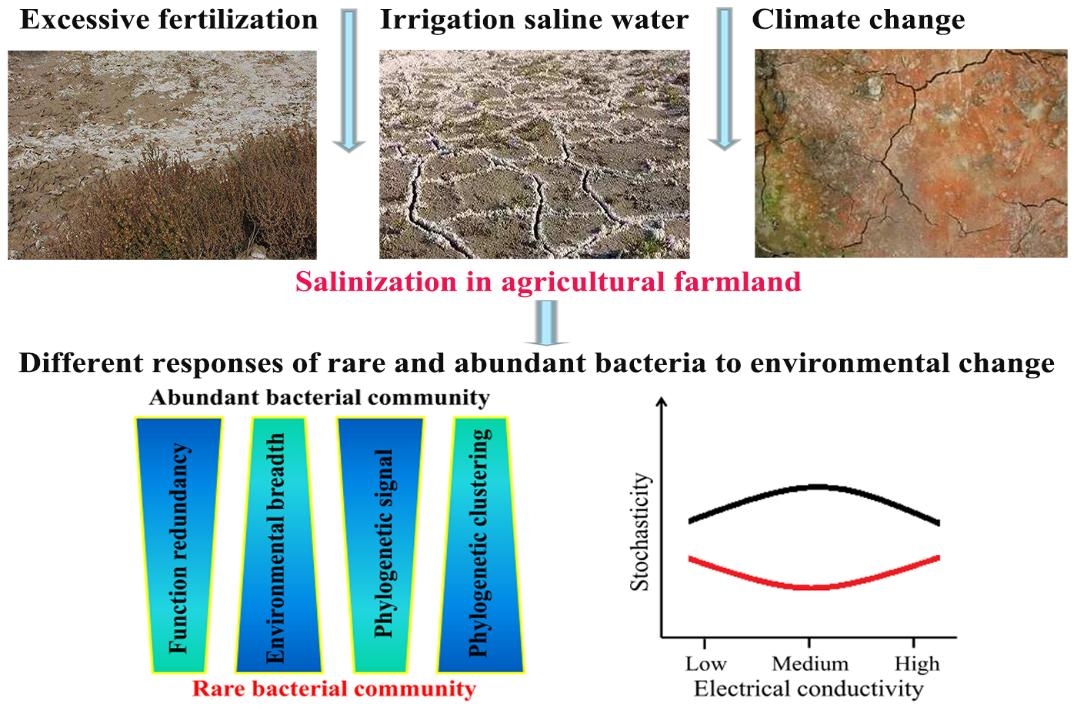Soil salinization, regarded as a "hidden killer of agriculture", is a globally agricultural problem threatening crop growth and productivity. Chinese farmlands, responsible for feeding 1.4 billion people, have to provide agriculture products as much as possible via applying fertilizers. Consequently, the excessive application of inorganic fertilizer leads to soil salinization, and low precipitation and poor agricultural management intensifies salinization.
Therefore, it is necessary to evaluate tillage potential of salinized agricultural soils via estimating soil ecosystem multifunctionality regarded as an important index for assessing soil nutrient turnover and retention as well as flora diversity. However, relationships between soil ecosystem multifunctionality and rare and abundant bacterial diversity are poorly understood.
Associate Prof. WAN Wenjie from the Wuhan Botanical Garden of the Chinese Academy of Sciences, collaborating with Prof. CHEN Wenli and Prof. HUANG Qiaoyun from the Huazhong Agricultural University,selected a salinized area in Yingcheng City (Hubei Province, China) as the research object, and determined community composition and diversity of soil bacteria and measured soil physicochemical properties and enzymatic activities.
Furthermore, the researchers employed multiple statistical analysis approaches to calculate ecosystem multifunctionality, community functional redundancy, environmental breadths, phylogenetic signals, phylogenetic clustering, and community assembly processes.
According to the researchers, abundant bacteria possess higher functional redundancies and stronger phylogenetic signals for environmental preferences than rare bacteria, while rare bacteria present closer phylogenetic clustering and broader response thresholds to almost all environmental varibales than abundant ones.
Variable selection contributes most to rare bacterial community assembly, while dispersal limitation and variable selection contributes largely to abundant bacterial community assembly. Salinity is the crucial factor adjusting the balance between stochastic and deterministic processes of both rare and abundant bacteria subcommunities in salinized agricultural soils.
Taxonomic a-diversity of rare bacteria and phylogenetic a-diversity of abundant bacteria show significant effects on ecosystem multifunctionality in salinized agricultural soils.
Meanwhile, taxonomic a-diversity of abundant bacteria and phylogenetic a-diversity of rare bacteria have little influence on soil ecosystem multifunctionality. Besides, abundant bacterial community functions contribute significantly to soil ecosystem multifunctionality, while rare bacterial do not.
Deciphering the diversity of rare and abundant bacteria and their contributions to ecosystem multifunctionality in salinized soils is critical for guiding soil restoration.
This research was funded by the National Natural Science Foundation of China, the National Key Research and Development Program of China, and the Technical Innovation Major Projects of Hubei Province.
The findings of this research have been published in mSystems with the title of "Bridging Rare and Abundant Bacteria with Ecosystem Multifunctionality in Salinized Agricultural Soils: from Community Diversity to Environmental Adaptation".







